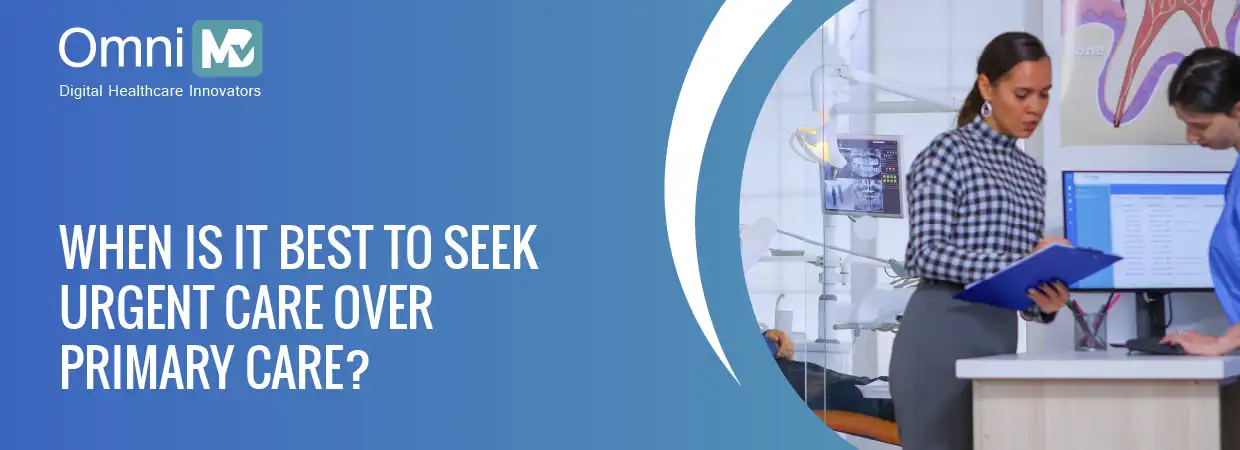When Is it Best to Seek Urgent Care Over Primary Care?
Whether we talk about waking up to muscle pain or not being able to sleep due to stomach discomfort, experiencing a feeling of dizziness, or going through sudden onset of toothache, realizing that now it has become unavoidable to see a doctor is something that we all have encountered, some more frequent than others.
In 2019, 32.3% of women and 26.0% of men had one or more visits to an urgent care center or retail health clinic in the past 12 months.
At that moment, when our emotions are heightened and the mind is barely able to process, deciding which is best to seek help from, primary or urgent care, adds up to the stress level.
Primary Care V/s Urgent Care: What You Need to Know
Both primary and urgent care address similar types of illnesses and injuries. The difference lies in their accessibility and purpose.
Your primary care physician is your main doctor, your first point of contact for acute and chronic conditions like diabetes, thyroid issues, or blood pressure.
In the case of primary care, you generally visit the same doctor throughout your life, and you visit them even when you are not ill but for annual check-ups and vaccinations.
Over time, your primary care practitioner develops a comprehensive understanding of your and your family’s medical history. This helps them diagnose, treat, and monitor your health more effectively and refer you to specialists when necessary.
Urgent care, on the other hand, provides treatment for non-life-threatening conditions that require immediate attention. It acts as an intermediary between primary and emergency care, catering to conditions that need prompt attention during times when regular medical offices are closed.
But, does that mean you can only seek urgent care when facing unavoidable suffering? Not exactly. You can also visit urgent care when your primary doctor is unavailable or out of town. However, urgent care is typically more expensive, and the doctors there do not have access to your medical history.
Though both primary and urgent care practitioners are equally qualified, in situations where you can wait, it’s advisable to visit your primary care physician, who knows you better and can provide more personalized and holistic treatment.

Reasons For Primary Care Visits
As mentioned, primary care physicians offer comprehensive and continuous care. The type of physician you should see depends on your age and health needs. Below, we have listed the most common types.
Family medicine physicians
Provides comprehensive and continuous care to individuals of all ages, genders, and diseases. Versatile in treating a multitude of health issues, they usually treat the entire family, from infants to seniors.
Reasons for visits
- Common colds
- Flu
- Minor injuries
- Hypertension
- Diabetes
- Behavioral Health
- Screening
- Vaccinations
- Smoking cessation, and more
Internal medicine doctors
They typically focus on adult care for people aged 18 or above and specialize in the diagnosis, treatment, and prevention of various complex and chronic diseases.
Reasons for visits
- Diabetes
- Neurological conditions
- Vascular and heart issues
- Respiratory problem
- Joint and arthritic diseases
- Mental health disorders
- Hypertension, and more
Pediatricians
Experts in the medical care of children. They are aware of the unique medical needs of young patients, addressing everything from vaccination to their developmental milestones.
Reasons for visits
- Developmental disorders
- Behavioral issues
- Vaccination and preventive care
- Growth and development monitoring
- Chronic conditions management
When to Seek Help from Urgent Care
If your health condition is not life-threatening but is too severe to wait for a scheduled appointment, urgent care is a suitable option. Also, urgent care is ideal if you do not have a primary care doctor, lack sufficient insurance coverage, or require medical attention outside of normal business hours.
Reason for visits
- Severe sore throat, cough, or fever : Symptoms may include a painful throat, persistent cough, high temperature, chills, and body aches.
- Moderate breathing or swallowing difficulties : Challenges with taking deep breaths, wheezing, chest tightness, or feeling like the throat is closing. Swallowing issues might include pain or difficulty in passing food or liquids.
- Nausea, rashes, or digestive issues : Skin eruptions that can be itchy or painful, and disturbances in the digestive tract such as bloating, cramping, or diarrhea.
- Persistent ear pain or eye discomfort : Constant earache, ringing in the ears, reduced hearing, or feeling of fullness. Eye discomfort might include redness, itching, tearing, or blurred vision.
- Stomach flu, vomiting, and diarrhea : Intense abdominal cramps, frequent vomiting, and watery stools.
- Kidney stone : Sudden, severe pain in the back or side, pain during urination, and frequent urge to urinate.
- Sprains and strains : Pain, swelling, bruising, and limited ability to move the affected joint or muscle.
- Swollen glands, and more : Noticeable swelling in the neck, armpits, or groin, sometimes accompanied by tenderness or pain.
Closing Thoughts: Is Urgent Care Becoming New Primary Care?
The number of Urgent Care Clinics (UCCs) has surged in the past few years, with reports highlighting a 100% increase in the United States from 2014 to 2023.
Also, Urgent Care centers are notably higher among Gen Z and Millennial consumers, with 36% having used these services in the past six months compared to only 19% of Boomers and the Silent Generation. The convenience and on-demand nature of Urgent Care services drive this shift.
However, these changes shouldn’t be considered a necessity or an alternative where UCCs can replace primary care; instead, a balanced approach that leverages the strengths of both UCCs and primary care is ideal.
People prefer visiting UCCs for on-demand and convenient care, while primary care is their go-to place for comprehensive, continuous, and coordinated care.
Moreover, UCCs are more expensive than primary care due to out-of-pocket expenses and many health insurance plans lacking urgent care coverage. Primary care, on the other hand, often comes at a predictable cost due to its coverage by health insurance plans, which include both private insurance and government programs like Medicare and Medicaid.
As the healthcare landscape continues to evolve, it is essential to recognize the unique roles of both urgent and primary care in providing comprehensive and accessible healthcare services. Understanding these roles and fostering collaboration can create a more integrated and effective healthcare system for all.

Best EHR for Your Urgent Care Clinic
Streamline your urgent care clinic operations and improve patient care effortlessly

 Written by Neha Singh
Written by Neha Singh
 Reviewed by Shivani Joshi
Reviewed by Shivani Joshi